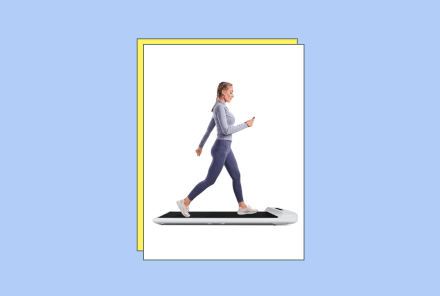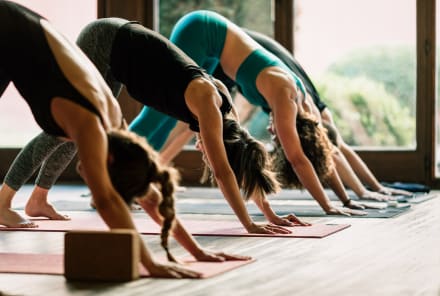Advertisement
How Often Should You Work Out? Planning A Perfect Schedule, According To Experts

There’s no uniform approach to getting stronger. Training is most effective when it meets us exactly where we’re at, physically and mentally. From the moves we choose, to the gear that carries us across the finish line, we deserve a regimen that works with us, not against us. With that in mind, we’re looking to Under Armour’s SmartForm technology, designed to fit the exact shape of our body (even in motion). We’re all unique, and once we harness that power: the sky’s the limit.
Whether it's the middle of a busy work season, motivation is low, or you're just beginning to build a consistent workout routine, deciding what type of exercise is best for you and how often to do it can be challenging.
To make it a little more straightforward, mbg spoke with personal trainers, physical therapists, and family medicine doctors to help gauge how often you should be working out and why variation matters. Plus, a two-week workout plan to help you get started.
How often should you be working out?
According to the Physical Activity Guidelines for Americans, the average adult should engage in at least 150 to 300 minutes of moderate-intensity physical activity every week. That's between two and a half and five hours per week. If you are performing high-intensity exercise, the guidelines recommend 75 to 150 minutes.
Because everyone's goals, age, and other factors will vary, the "right" workout plan will differ. Here are a few general strategies, broken down by goal:
Weight loss
"As a general rule, weight loss equals calories consumed minus calories burned," family medicine physician and certified personal trainer Michele Reed, D.O., tells mbg. Generally, a safe weight-loss goal is one-half to 2 pounds per week, she adds. Based on that rule, nutrition and exercise play a role in healthy weight loss.
Before embarking on a weight loss plan, chat with a physician and/or nutritionist to find out what is safe and what will work best for you.
In terms of exercise, strength and conditioning coach Mark Barroso, CSCS, CPT, recommends strength training. That's because it helps keep your body in an anabolic state, he says, "where protein is formed from amino acids to help us build muscle and recover from tough workouts."
Just keep in mind: Muscle weighs more than fat, Reed says, so you may not lose as much weight when you first start putting on muscle. However, "your clothes will fit differently, and your body will perform/respond better in the long run," she adds. Also keep in mind that having muscle on your body helps burn more calories, even when you're not actively exercising.
Additionally, the process of losing weight is dependent upon healthy habits. These healthy habits can be small things that add up to big change (i.e., cutting out dessert during the workweek or no snacking after 6 p.m.). Reed recommends trying to set and keep those habits consistently for 30 days. "These 30 days become great building blocks for long-term success," she says. Actually seeing the results of those healthy habits may take between four and six months, though, so be patient.
Strength
According to NASM-certified personal trainer BB Arrington, "Moving your body against resistance is the best way to gain strength. That could be bodyweight exercise, or exercises with resistance bands, dumbbells, barbells, or gym machines."
"If you are new to strength training, it will take a little bit of time to figure out your baseline," Arrington tells mbg. "If you're comfortable with the movement pattern, figure out your RPE (rate of perceived exertion). On a scale of 1 to 10, with 10 being maximum effort, it's a subjective measure of how hard the exercise is," she explains.
Arrington recommends working in the medium-high repetition ranges as a beginner to help master the technique and form. "Generally speaking, two to three sets of the exercise should be a solid start. If we used a medium-high range of 12 to 15 reps, aim for your RPE to be six to eight. There's no need to hit 10s," she says.
When strength training, Arrington says to frequently check in with your body and make sure your form is strong. "How do you know if your form is solid? If you feel the energy in the muscles intended without adverse sensation and manipulation from other body parts," she says. For example, if you're doing a squat, you should feel the tension in your glutes, not your back.
As for choosing the right weights, the last two reps should feel extra challenging but not so much that your form falters. If you crank through all your reps with ease, it may be time to try slightly heavier weights.
Ultimately, it's about tuning in to your own body to know when it's time to level-up your intensity: "There are principles but no rules when it comes to strength training."
Muscle building
Muscle building (aka hypertrophy) occurs when the muscle fibers grow in response to increased levels of tension—and the best way to create those conditions is with resistance training. When you're trying to build muscle, it's generally recommended to go for intermediate reps with progressively heavier, more challenging weights. "If you do 10 reps, let's say, and only ever meet an RPE of 5, don't expect to see changes," Arrington says.
In the muscle-building phase of training, Barroso recommends targeting specific body parts rather than repeating individual lifts every week. For your schedule, he recommends "lifting three to four days per week and doing cardio three to four times per week." It may take about eight to 12 weeks to see results.
Endurance
"Endurance athletes like runners, cyclists, and swimmers often train using bodyweight or very light weights for 20-plus reps per set," Barroso says. "Their goal isn't to increase absolute strength or muscle size—it's to increase the number of contractions (even if not very forceful) the muscle can produce in a certain amount of time."
Performing more repetitions with lighter weights is one of the best ways to build stamina or endurance. If your goal is endurance, he recommends reducing weightlifting to once or twice a week and adding in HIIT and long steady-state cardio (think a longer run or bicycle ride) a couple of times a week.
"A mix of all three methods—strength, hypertrophy, and endurance—will yield the most functional athlete," he says.
Can you work out too much?
While staying physically active is critical for physical and mental health, it is possible to work out too much. Aside from all of the factors above (weight loss, strength, muscle, endurance), the next most important component is rest, Reed says.
"Overtraining occurs when the body partakes in too much exercise with not enough rest/recovery time," says Kristin Westover, P.T., MPT, CIMT, clinical director at Professional Physical Therapy in New Jersey. "This places undue stress on the body and can lead to overuse conditions such as tendinitis. Signs of overtraining to be aware of are soreness, fatigue, impaired sleep quality, increased weakness, and mood changes," she adds.
Why variation is key.
Cross-training or variation can help reduce the risk of overuse injuries, but it's also important for meeting different goals. For example:
Strength: "Within the strength goal, doing variations of the exercises (like squat, deadlift, overhead press, and power clean) will help you get stronger at those same exercises," Barroso says.
Muscle building: "Variation is especially important because changing the angle at which you pull or push can target different areas of each muscle," he explains.
Endurance: Endurance athletes benefit from variation to reduce the risk of injury and keep exercise interesting. "A runner with a knee injury may need to do swimming to maintain their aerobic fitness," he says, and "a runner that can't seem to get any faster may see improvements from working on a bike and vice versa."
A two-week routine to get started.
OK, so that was a lot of information—if you're still not sure where to start, Barroso created a two-week routine to help. It includes eight workouts (four running and four strength training) and, according to Barroso, is designed to improve running speed, muscular strength, cardiorespiratory health, muscle size, flexibility, and overall functional fitness.
Equipment needed: Kettlebell or dumbbell. Resistance band with handles.
Week 1
- Day 1: Run 20 minutes
- Day 2: Strength Workout A
- Day 3: Running Workout A
- Day 4: Strength Workout B
- Day 5: Running Workout B
- Day 6: Rest. Use today to stretch your whole body, either on your own or guided by a yoga class.
- Day 7: Run 45 to 60 minutes
Week 2
- Day 8: Rest. Use today to grocery shop and meal prep 5 to 10 meals.
- Day 9: Strength Workout C
- Day 10: Running Workout C
- Day 11: Strength Workout D
- Day 12: Running Workout D
- Day 13: Rest
- Day 14: Run 45 to 60 minutes
The workouts:
Strength
Strength workout A:
0.5-mile run, 20 walking lunges (each side), 0.3-mile run, 30 jump squats, 0.25-mile run, 20 burpees, 0.25-mile run, 10 pushups
Strength workout B:
4 rounds total: 40 seconds active, 30 seconds resting
90 seconds rest between rounds. Total time: 30 minutes
squats, reverse lunge, mountain climbers, dips, pullups, resistance-band upright row
Strength workout C:
3 rounds: 20 reps each exercise
kettlebell swings, resistance-band curls, kettlebell goblet squats, resistance-band front raise, kettlebell overhead triceps extension, resistance-band bent-over row
Strength workout D:
3 rounds
20 situps, 10 V-ups, 10 bicycle crunches (each side), 30- to 60-second plank.
Then as many reps as possible (AMRAP) in five minutes:
10 pushups, 10 box jumps
Running
Running workout A:
8 rounds
1-minute hard run, 1-minute walk/jog.
Running workout B:
Total time: 30 minutes
Run up an incline; run back down. Work at about 80% effort.
Running workout C:
Five 400-meter laps, alternate between:
200 meters fast (5K pace), 200 meters jog (30 seconds slower)
Running workout D:
run, lunge, burpee; 3 rounds
400-meter run, 200-meter walking lunge, 10 burpees
Watch Next
Enjoy some of our favorite clips from classes
Enjoy some of our favorite clips from classes
What Is Meditation?
Mindfulness/Spirituality | Light Watkins
Box Breathing
Mindfulness/Spirituality | Gwen Dittmar
What Breathwork Can Address
Mindfulness/Spirituality | Gwen Dittmar
The 8 Limbs of Yoga - What is Asana?
Yoga | Caley Alyssa
Two Standing Postures to Open Up Tight Hips
Yoga | Caley Alyssa
How Plants Can Optimize Athletic Performance
Nutrition | Rich Roll
What to Eat Before a Workout
Nutrition | Rich Roll
How Ayurveda Helps Us Navigate Modern Life
Nutrition | Sahara Rose
Messages About Love & Relationships
Love & Relationships | Esther Perel
Love Languages
Love & Relationships | Esther Perel

















